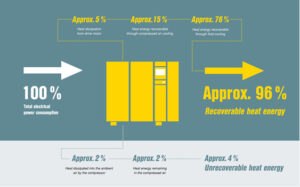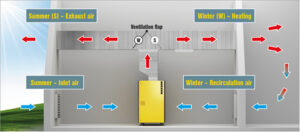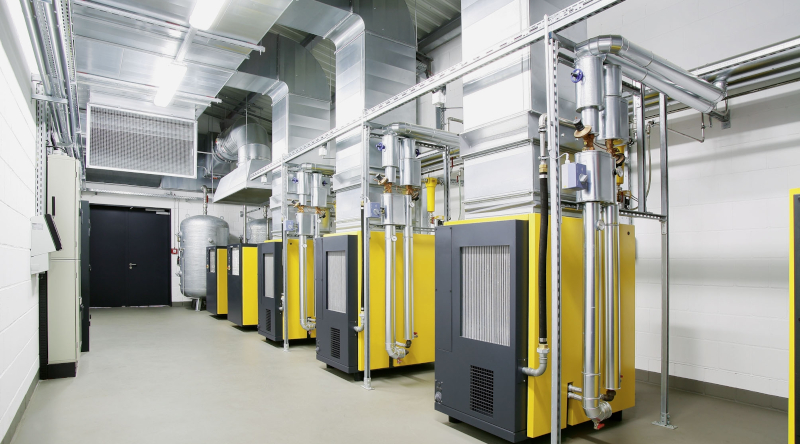Sustainable savings
Heat recovery saves money and benefits the environment
based on an article by Daniela Koehler, Press Officer at Kaeser Kompressoren
Photo top: Compressed air station with air ducts for heat recovery. The ducts convey hot air to neighbouring spaces.
Compressors and the compressed air they generate are used in a multitude of industrial applications. However, the fact that compressor exhaust heat can be harnessed often remains forgotten. Up to 96% of the drive energy supplied to a compressor is available for reuse. Heat recovery not only saves energy and costs, but also reduces the operator’s CO2 footprint.
Fully 100% of the drive energy supplied to a compressor is converted into heat. Both air- and fluid-cooled rotary screw compressors are exceptionally well-suited to comprehensive recovery and reuse of this energy; around 76% of their energy input remains as heat in the cooling fluid and is removed in the fluid cooler. A further 15% can be recovered as heat via the compressed air aftercooler. Up to 5% of the heat produced is emitted by the electric motor – with targeted cooling, fully enclosed rotary screw compressors can even recover this energy as well. Only 2% of the total energy input is lost as heat radiation, whilst a further 2% remains as heat in the compressed air.
Of course, this heat could simply be conveyed away. However, there are plenty of ways to make use of this readily available energy source that occurs as a by-product of the compression process. The simplest and most efficient method is to use the compressor exhaust heat directly, e.g. for heating adjoining rooms or spaces. Here, instead of discharging hot air from the compressed air station outside, an air ducting system directs it to neighbouring warehouses or workshops. When no hot air is required, the heated exhaust air is simply conveyed outdoors by means of a flap or louvre. A thermostatically controlled louvre enables hot air to be provided as and when required in order to maintain a constant temperature.
In addition to providing full or supplementary heating for operating spaces, hot compressor exhaust air can be used to support applications such as drying processes, generating hot air curtains or preheating burner air for heating systems. The corresponding investment costs can often be amortised within a period of one year.
Compressor exhaust heat can also be used to supply existing hot water heating and service water systems; depending on the available storage capacity, water temperatures of 70 °C and even higher can be generated. There are several ways to achieve this. The most cost-effective method is to use a plate-type heat exchanger integrated into the compressor, which is connected to the compressor cooling fluid circuit and transfers energy from the heated cooling fluid to the water that requires heating. Depending on whether the hot water is required for particularly sensitive production or cleaning processes, for showering and washing, or for general heating systems, special safety heat exchangers or conventional plate-type heat exchangers may be used. These enable 70-80 % of the installed compressor output to be used for heating purposes without the need for any additional expenditure on energy. This variant of heat recovery is also possible with primary water-cooled rotary screw compressors. Heat recovery is principally worthwhile when the compressors in question feature a power output of at least 5.5 kW.

Establishing actual requirement
Since very few operators know their exact air demand, Kaeser recommends conducting a compressed air audit before installing a compressor system. Performed swiftly and seamlessly using state-of-the-art analysis tools such as the ADA/KESS (Air Demand Analysis/Kaeser Energy Saving System), this audit can determine the precise demand data for a project, says the company. The web-based system transmits measured data and system data for the audited station, and provides an initial report for the operator. These data can then be transferred to the KESS system and subsequently used to determine the planning steps for the air station operator, as well as the investment costs and potential for energy savings. In the case of a completely new installation, optimised solutions are devised and suggested from the outset so that the operator can compare independently between different system variants and select the most cost-efficient choice. Where building management systems are used, it is recommended to conduct a thermal audit in conjunction with the compressed air audit so that the heat balance can be determined in parallel with the air consumption. This allows thermal data such as temperature flow and return to be investigated in addition to compressed air data such as volume, pressure and required air quality.
Once these details are established, it can be determined what percentage of the compressor exhaust heat can be absorbed into the normal heat requirement of the project. This in turn allows the size of the storage vessel and the required temperature to be calculated. In the best-case scenario, 96% of the heat output can be used.

A few points must be taken into account when planning or optimising a compressed air station. For example, compressors and heating systems should not be placed in the same room, since optimal use of these requires different room climate conditions and the compressor must not be permitted to draw in dangerous admixtures. The compressor room needs to be well ventilated; the room for the heating system does not. In an ideal world, the two rooms would be separate but situated near to one another, so that the ducting route between compressors and heating system can be as short as possible. Even when the two systems are positioned apart, the heat from the compressors can be used to heat the burner intake air for the heating system.
Since the volume of accumulating heat and the heat requirement are rarely identical, it is important to ensure that there is sufficient thermal storage potential in the form of large vessels. This guarantees optimum supply when generation and consumption volumes differ, as happens in the case of a house equipped with solar heating, where it also necessary to install a means of thermal storage so that hot water is still available when the sun is not shining.
Air- or water-cooled compressors
Once the design has been decided, it is vital to select the correct compressors. In general, two different cooling methods are available for compressors: air cooling and water cooling. As already mentioned, in the case of the former, air ducts with thermostatically controlled flaps convey the hot exhaust air directly from the compressors to the neighbouring operating spaces, in order to provide heating for example. To minimise heat losses, the distance the exhaust air needs to travel from the compressor to the point of use should not be too great.
According to Kaeser, air-cooled rotary screw compressors, available with up to 315 kW of power, can offer significant heat recovery potential — an investment that typically pays off quickly, with costs often amortised within a year. Systems equipped with additional hot water heat recovery can supply water at temperatures up to 70 °C throughout the year, and even higher if needed. However, since these systems have an impact on compressor power consumption, it should be checked beforehand that their use is justifiable from a cost-efficiency point of view.
In the case of water-cooled compressors, the user-end requirements and cooling water costs also play an important role; in principle, however, heat recovery as described above can also be achieved here by means of a second connected circuit.

